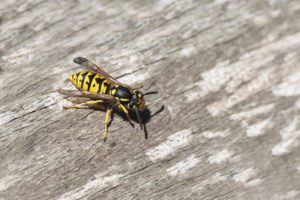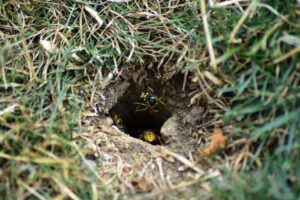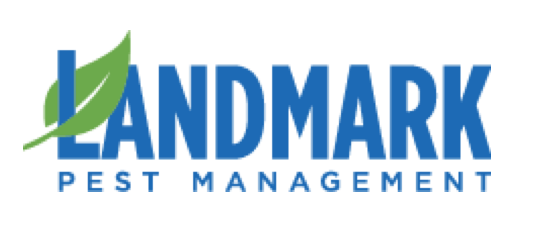Yellow jackets are a familiar summertime nuisance. Due to their striped black and yellow coloring, they are often mistaken for bees, but these members of the wasp family have different living habits and pose a greater stinging risk than bees. Summer offers many opportunities to eat outside, and since yellow jackets enjoy food just like we do, it’s perfectly normal to encounter them at a barbecue, picnic, or park. But if you’re noticing a persistent problem around your home or business, there might be a nest on your property, and yellow jacket removal may be necessary.
Identifying a Yellow Jacket

Identifying a Yellow Jacket Nest
While it is possible for yellow jackets to build an exterior nest, they are primarily a cavity-dwelling species. In structures, they are usually found inside walls, in attics, soffits, inside sheds, or anywhere there is a sheltered void space. It is also very common for them to nest underground, often in abandoned rodent burrows. Since the nest itself may not be easy to locate, pay attention to “airport activity”. Where do you see the largest number of
Yellow jackets build their homes by chewing wood fiber or drywall into a pulp that they then form into papery nests. This is especially problematic when they are living between two walls, as they may begin to chew through the drywall. Nests are gray or brown with a wavy texture and typically only have one entrance. Unlike bees who maintain their hives through the winter, yellow jacket colonies only last one season, dying off when it gets cold. Fertilized queens will find a suitable place to overwinter – which is why you may occasionally see a yellow jacket in the fall or winter – and then produce new colonies the next spring.
Treating a Yellow Jacket Nest
Yellow jackets are a social species, which means they will become aggressive when defending their colony. They are able to sting over and over again without injuring themselves, and if they view you as a threat, they will not hesitate to attack. For this reason, ABC Humane Wildlife does not recommend attempting yellow jacket removal on your own. It’s far too risky for you and your family. Instead, contact a yellow jacket removal specialist. ABC Wildlife technicians have over three decades of experience locating and extracting yellow jacket nests. They have the training and proper equipment to return your home or business to its safe, stinging insect-free state. Contact us today at (847) 870-7175.
Vito Brancato is a wildlife specialist and educator with over 15 years of animal and pest management experience. He is a certified Wildlife Control Operator through the National Wildlife Control Operators Association and belongs to the National Pest Management Association and the Illinois Pest Control Association. He is an avid beekeeper and nature enthusiast.



